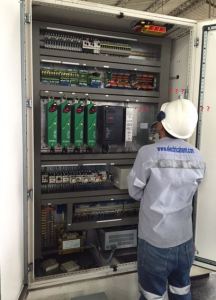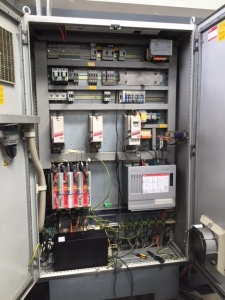Replacing Cooling Fans with Cabinet Coolers
When an electrical device mounted inside a control panel goes offline due to an overheating condition, it can be difficult to determine which component in the panel is the root cause. There may be an intermittent heat load from a variable frequency drive that isn’t present when troubleshooting, making things appear to be OK. Or, the overheating condition may only happen during peak operation on days with high ambient temperatures.
Fortunately, no matter the root cause, an EXAIR Cabinet Cooler can maintain temperature within the enclosure at a desired set-point, eliminating overheating conditions and lost throughput due to downtime.
When calculating heat load, EXAIR Application Engineers consider the components within the control panel. We inquire with our customers regarding devices such as VFD’s, which may lead to temperature spikes, or fans, which actively remove heat (albeit that they often force dirt and debris into the enclosures they’re designed to be cooling).
Fans can be particularly important, because with the installation of any EXAIR Cabinet Cooler, all external fans will need to be removed, and their openings will need to be sealed (internal fans can remain in place). So, this means we have to account for any heat the fans may already be removing from the application, even if it isn’t enough to keep the enclosure cool.
In order to determine the amount of heat a fan is removing from an application, we consider the diameter of the fan, which corresponds to a typical air flow volume in CFM (cubic feet per minute). We then consider that 1 BTU/hr. is the amount of heat required to raise the temperature of one pound of water by 1 degree Fahrenheit, and it is also the amount of heat needed to raise/lower the temperature of one cubic foot of air by 1 degree Fahrenheit in one minute. This means that for every CFM the fan is moving, we are reducing the temperature of the air by 1°F . To put it another way, we remove 1 BTU/hr. for every °F * every CFM the fan is moving.
As an example, a 3″ fan will move 22 CFM. In an enclosure with a current temperature differential of 15 degrees Fahrenheit, this fan is removing 330 BTU/hr.
15°F * 22 CFM = 330°F*CFM
15°F
| x | 22 CFM | X | 1 Btu/hr | = | 330 Btu/hr |
CFM °F
|
The fans holes should be covered up with sheet metal using rivets, caulk/sealant, duct tape or other ingenious methods you know of. But please cover and seal the cabinet as well as you can.





No comments:
Post a Comment